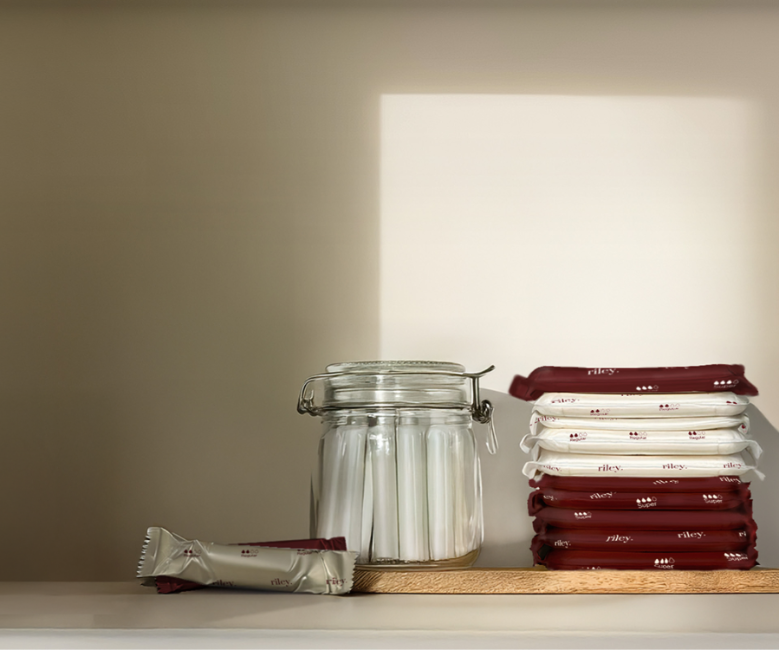As a lot of you may know, Riley was founded on the belief that our bodies deserve better. Riley is a product of our own frustration with how the period care industry is run and after extensive research into the products we had been using since our first period we were determined to do something about it.
We’re sure many of you have read the recent headlines detailing a new California Berkeley study that tested for metals found in various tampon samples. We’ve been in contact with our manufacturers and independent testing organisations to ensure we have the most up to date and accurate information possible and we’re determined to address all questions and queries that our community have (understandably) sent our way in light of the new study.
We want to provide as much reassurance to you all as possible by explaining the findings of the study while also detailing the high level of quality, care and safety that’s involved in every aspect of how our business is run, but most importantly, in the manufacturing of our products, so let’s talk about them first.
Our Products
When we initially started researching the period care industry back in 2020 when Riley was still an unnamed idea we were shocked by what we found and that led us down a rabbit hole of information. Since then, it’s been our mission to provide accessible, healthier and sustainable period care for all those who menstruate.
At the very beginning of our Riley journey, it was a unanimous decision and went without question that we used only the best quality organic cotton to produce our pads, tampons and pantyliners. While harmful fertilisers and pesticides are often used in conventional cotton farming, organic cotton is grown without the use of these substances which in turn significantly reduces the risk of contamination. So, after countless calls, questions and careful consideration, our manufacturers were chosen based on shared values, the highest quality sourcing and production, and regular internal and independent testing.
We’re proud to say that our products are independently tested and certified with multiple third party organisations including:
- The Global Organic Textile Standard (GOTS) was developed by 4 leading standard setters to define the worldwide leading textile processing standard for organic fibres, including ecological and social criteria, backed up by independent third-party certification of the entire supply chain. GOTS has strict regulations for the presence of chemical substances that could pose potential health and safety risk. It sets limit values for several chemicals, including heavy metals.
- OEKO-TEX® consists of independent textile and leather testing institutes that conduct both laboratory tests and company audits in accordance with our global guidelines to ensure organisations accurately manage risk, meet legal requirements, and protect both people and the planet.
- Eurofins is a global network of leading laboratories providing an unparalleled scope of testing services for a wide range of consumer product categories.
- Standard ISO 10993: Biological evaluation that covers cytotoxicity, sensitisation, acute systemic toxicity, intracutaneous irritation and vaginal mucosa irritation test.
- Dermatest® is an independent dermatological institute which gives you the maximum possible confidence when it comes to products for your skin.
As mentioned in the study, researchers suggest that substances added during the manufacturing process like antimicrobial, odour control and lubricants could potentially be sources of metals. No additional substances are added to our tampons during the manufacturing process.
The University of California, Berkeley Study
Researchers from the University of California, Berkeley tested 24 unique types of tampons from 14 different brands to examine for traces of various metals. The tampons used in the study included mainly non-organic brands but also a small number of organic tampons and were purchased from areas across the US and Europe. Headlines about the study (that are sure to stop you in your tracks) have been circulating online and have generated a completely justified cause for concern based on the fact that metals such as arsenic and lead were included in the findings.
In the study, assumptions have been made on the results of how these elements have been added to tampons, including antimicrobial purposes, odour control and lubrication. Just to reiterate, we do not add any of these metals to our products for these purposes. In fact, none of these substances are deliberately added to our products during manufacturing. Another theory linked to the study on how the metals have ended up in these tampons is general environmental exposure that affects soil, water and air.
The study specifically mentions this could be the case for the organic tampon samples used saying that “application of natural fertilisers in organic cotton fields (e.g., animal waste or plant-based compost), which can lead to geochemical changes in soil by altering pH”. And we’re in full agreement with the researchers on their point saying “although more studies are needed to confirm this hypothesis.”
GOTS and Eurofins both have their own strong system to tackle controlling the presence of hazardous chemicals, including heavy metals, and our products have certificates from both independent organisations.
Our Thoughts
Considering women weren’t included in clinical trials or studies until 1993 and the fact that the female health industry is a massively underserved market as it is, we have always championed more research and funding for female health. This includes product safety for menstrual products, both as a company and as individuals because our entire team uses our products every single month and will continue to use our products every single month.
Despite existing regulatory controls and independent product testing, such as the FDA, EDANA and GOTS, studies like this and the headlines that follow can still leave us feeling concerned, and even a little bit confused. So let’s break it down a bit…
First of all, we deserve clarity and accuracy when it comes to our bodies and the products we use and unfortunately, the narrative surrounding the study has been lacking in both these areas since it began circulating online. This “exploratory” study (and the first of its kind) has been gaining so much attention online from a few harrowing headlines and while we welcome more and more studies of this kind, it’s very difficult for us to take the information included in the headlines and articles at face value.
Below we’ll be discussing some limitations of the study based on academic analysis from doctors within the industry, but we’re not trying to invalidate the findings whatsoever. Instead we’re aiming to bring another idea to the table whereby we can value the findings of this study while also needing and appealing for many more studies and research to back up the different theories and hypotheses within the Berkeley study.
With that in mind, we highly recommend looking into the following articles and videos:
- Dr. Andrea Love: Immunologist, Microbiologist with over a decade of experience in basic sciences, translational medicine, and clinical research. Dr. Andrea dives into the details of the study in her article and draws upon some interesting conclusions. She explains how the method used for extracting the metal substances was 70% nitric acid combined with 82 degrees celsius heat, and “what that means is that anything extracted from these tampons is not representative of what might leach out of a tampon during actual use of it.” i.e. these conditions are not representative of the kind you'd find inside a vagina.
- Dr. Karan Rajan: NHS Surgeon and Clinical Lecturer at Imperial College London & University of Sunderland. Dr. Karan has created a helpful tiktok to help us understand some real life comparisons to the results of the study
- Dr. Jen Gunter: OB/GYN and Author of The Vagina Bible and The Menopause Manifesto. Dr. Jen goes into a huge amount of detail in her article about the metals in tampons using digestible language to help understand exactly what the study is saying.
We completely understand that seeing the words “arsenic” and “lead” in the same sentence as the word “tampon” would have alarm bells going off in your head, but in actual fact, the situation is a lot more nuanced than the headlines will have you believe. But the release of this study is absolutely a step in the right direction and will hopefully encourage a domino effect for more of its kind to help validate the findings in a more accurate way.
Where do we go from here?
Finally closing the gender health gap.
Are we unhappy because studies like this are only coming out now? Of course, female health studies and research should be given equal and fair resources as that of the male counterparts, but that's simply not the case right now, and never has been.
Which is why we’re appealing for the release of this study to ignite true change in the female health industry. Not only in studies and clinical trials, but in diagnosis, childbirth, and generally advocating for females more, especially black women and people of colour. We want this study to be the beginning of finally closing the gender health gap because we all deserve the best care when it comes to our health, no matter our gender.
Regulatory Responsibility
Finally, in terms of our current tampon regulations, the FDA classifies both scented and unscented tampons as a class II medical device (or “moderate to high risk”), meaning they do require special regulatory controls. All riley tampons are unscented and do not contain additional or unnecessary ingredients.
They are currently reviewing the study but they’ve released a statement saying:
“All studies have limitations. While the chemical method used indicates these metals are present in the tampons tested in the laboratory, the study does not assess whether any metals are released from tampons when used in the body. It also does not address whether any metal, if released, can be absorbed into the vaginal lining or, subsequently into the bloodstream.”
This is because the method used for extracting the metal substances was 70% nitric acid combined with 82 degrees celsius heat. In comparison, the average vagina is a is roughly 37 degrees celsius and a pH of 4.5. This means the nitric acid used in the test is nearly 200 times more acidic than a vagina, and therefore not representative of the kind of conditions you'd find inside a vagina. Basically, anything extracted from these tampon samples is not representative of what might be released from a tampon during actual use of it.
They also said:
“We plan to evaluate the study closely, and take any action warranted to safeguard the health of consumers who use these products."
Our manufacturers not only meet current regulatory standards but they are also committed to consistently testing and to evolving based on test results and regulatory changes.
We assure you that we will be staying on top of this and posting updates as they come because your health, wellbeing and trust in us comes above all else.
If you have any questions or even an article or video you think we should see, don’t hesitate to reach out to us on Instagram DM or email us at hello@weareriley.com - we’re always happy to help.



